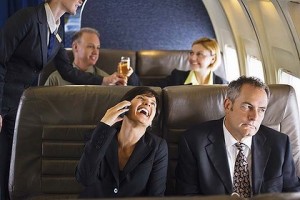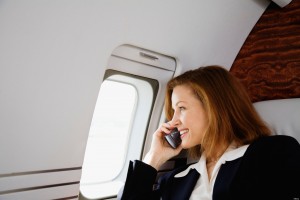By Erica Rascón on December 20, 2013 in Technology
Which do you value most during a flight: peace and quiet or the ability to get more work done? Busines s travelers across the globe may have to ask (and answer) that question when booking their next flight.
s travelers across the globe may have to ask (and answer) that question when booking their next flight.
The Federal Communications Commission has proposed to lift its ban on in-flight cellular communications. This means chatting it up and conducting business at 5,000 feet. A poll by the Federal Aviation Administration reveals that 61 percent of people are in favor of keeping the ban right where it is.
Travelers applauded the arrival of in-flight internet. The provision opened the doors for leisure and business travelers alike to entertain themselves with their tablets, smartphones and laptops. No more making awkward small talk with the stranger sitting next to you, or suffering with a teething baby during a transatlantic flight. Hulu Plus could rescue us all.
But maybe the FCC has taken in-flight communication a step too far with phone calls. With the addition of earphones, enjoying the features of most mobile devices does not impose on other travelers. Phone calls, however, will necessarily increase noise levels and create more scenarios for friction between passengers. The topic, duration, volume, and language used during conversations will no longer be limited to the few passengers sitting around the device user. The conversation can exist between the device user, nearby passengers and everyone else in their social circles. A 55-passenger flight can easily sound like a 110-passenger flight, or more if someone gets creative with a video conference call. That’s a lot of noise.
Added noise is only one level of concern. The second is the end of in-flight rest. It could be said that a long flight would at least allow time for a catnap or even a full on night’s sleep. With higher noise levels in the air, business travelers cannot expect a moment’s respite. Travelers may be expected to receive, return and process calls while in the air and then hit the ground running as soon as they land. What jet lag?
 In case the ban is lifted, a few possible solutions have already been tossed onto the table. Quiet cabins were introduced to a few foreign airlines to serve as a barrier between adult passengers and screeching babies. If the ban lifts, more American lines may adapt the feature. It’s simple: in addition to first class, business class, and coach there may be designated quiet zones on planes of the future, separated by Plexiglas or another noise barrier that’s more effective than the current tiny curtains. Another less popular option would be separate flights, in which everyone on the flight has committed to observe a certain noise level.
In case the ban is lifted, a few possible solutions have already been tossed onto the table. Quiet cabins were introduced to a few foreign airlines to serve as a barrier between adult passengers and screeching babies. If the ban lifts, more American lines may adapt the feature. It’s simple: in addition to first class, business class, and coach there may be designated quiet zones on planes of the future, separated by Plexiglas or another noise barrier that’s more effective than the current tiny curtains. Another less popular option would be separate flights, in which everyone on the flight has committed to observe a certain noise level.
Manuel Rathman travels frequently as a security contractor. He received the news of the potential ban lift with mixed sentiments. “I’m on the road a lot so it would be nice to check in with the kids, spend some time with them during the flight instead of wasting it watching a movie and then having to call them when they’re nearly asleep,” says Rathman. “The downside, though, is that everyone else may have the same idea,” he laughs. “Just the thought of everyone shouting into the handsets trying to hear over other passengers sounds like a nightmare.”
But Rathman has settled for a realistic outlook. “When you think about it, though, people are allowed to talk on the phone in restaurants, on buses, and stuff like that. It’s rarely that big of a problem. It will just take some getting used to.”


